Worldwide spending on edge computing is expected to be $232 billion in 2024, an increase of 15.4% over 2023.
Worldwide spending on edge computing is expected to be $232 billion in 2024, an increase of 15.4% over 2023. According to a new forecast from the International Data Corporation (IDC) Worldwide Edge Spending Guide, combined enterprise and service provider spending across hardware, software, professional services, and provisioned services for edge solutions will sustain strong growth through 2027 when spending will reach nearly $350 billion.
IDC defines edge as the information and communications technology (ICT) related actions that are performed outside of the centralized datacenter, where edge is the intermediary between the connected endpoints and the core IT environment. Characteristically, edge is distributed, software defined, and flexible. The value of edge is the movement of computing resources to the physical location where data is created, transacted or stored, thereby increasing enablement of business processes, decisions, and intelligence outside of the core IT environment.
“Edge computing will play a pivotal role in the deployment of AI applications,” said Dave McCarthy, research vice president, Cloud and Edge Services at IDC. “To meet scalability and performance requirements, organizations will need to adopt the distributed approach to architecture that edge computing provides. OEMs, ISVs, and service providers are taking advantage of this market opportunity by extending feature sets to enable AI in edge locations.”
Worldwide spending on edge computing is expected to be $232 billion in 2024, an increase of 15.4% over 2023, according to a new forecast from the IDC Worldwide Edge Spending Guide.
Fintech Insights: Hyper-personalization in Banking: The Tech Journey to Serving a Segment of One
Across 19 enterprise industries, IDC segments edge ICT spending for more than 500 named enterprise use cases in six domains. In the service provider industry, investments for edge services delivery is built on infrastructure spending for multi-access edge computing (MEC), content delivery networks, and virtual network functions. Combined, these three use cases will account for nearly 22% of all edge spending this year.
For enterprise adopters, including the public sector, examples of edge named use cases with large investments and rapid growth through 2027 include augmented maintenance (augmented reality), production asset management, AI-augmented supply and logistics, augmented diagnosis and treatment systems, supply chain resilience, in-home remote patient monitoring, and in-store contextualized marketing. Examples of emerging edge use cases that are forecast to have the fastest spending growth over the 2022-2027 period include autonomous mining operations, site design and management (construction), pipeline inspection (utilities), augmented training (multiple industries), and expert shopping advisors & product recommendations (retail).
“Enterprise investments have continued to shift the past 24 months toward infrastructure expansion and greenfield deployments. Companies are acting on plans to build more robust local computing infrastructure capabilities. And through it all, customer-facing new services and products and enabling new business processes are top enterprise drivers,” said Marcus Torchia, research vice president, Data & Analytics at IDC. “Over the next two years, the share of planned investments moderately favor MEC offerings. Yet in the balance, enterprises are looking to rationalize total service provider outlays. This sets up a dynamic market of capex and opex based edge offerings competing for investment dollars through 2027.”
Across enterprise end user industries, the sheer size of discrete and process manufacturing will account for the largest portion of investments in edge solutions this year, followed by the retail and professional services industries. IDC expects all 19 enterprise industries profiled in the spending guide will see five-year compound annual growth rates (CAGRs) in the low-to-mid teens over the forecast period. The service provider segment will see the greatest CAGR of 19.1%.
The largest investment share will continue to be led by hardware, at close to 40% of total spending, to build out edge capabilities especially driven by service provider infrastructure. Hardware spending will be driven by investments in edge gateways, servers, and network equipment. Over the forecast period, adoption of provisioned services by enterprises will surge, surpassing hardware share by 2026 for the first time. Within provisioned services, connectivity and IaaS will represent the greatest share and fastest growth categories, respectively. On-premise software will be a critical component of edge infrastructure but remain the smallest category in terms of overall spending.
From a geographic perspective, the North America will be the edge spending leader throughout the forecast period capturing more than 40% of the worldwide total share, followed by Western Europe and China, respectively. China and Middle East & Africa will experience the fastest spending growth over the five-year forecast with CAGRs of 16.2% and 15.3%, respectively.
The IDC Worldwide Edge Spending Guide quantifies the edge computing market by forecasting enterprise and service provider spending across 22 technology markets, six technology domains, 19 enterprise industries, and nine geographic regions. This version (2024 v1) of the Edge SG also includes more than 500 use cases that were segmented across various industries and domains.
Read More About Fintech Interviews: How Blockchain-Powered Ecosystems Are Poised to Transform the Agricultural Sector
[To share your insights with us, please write to pghosh@itechseries.com ]
